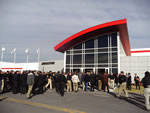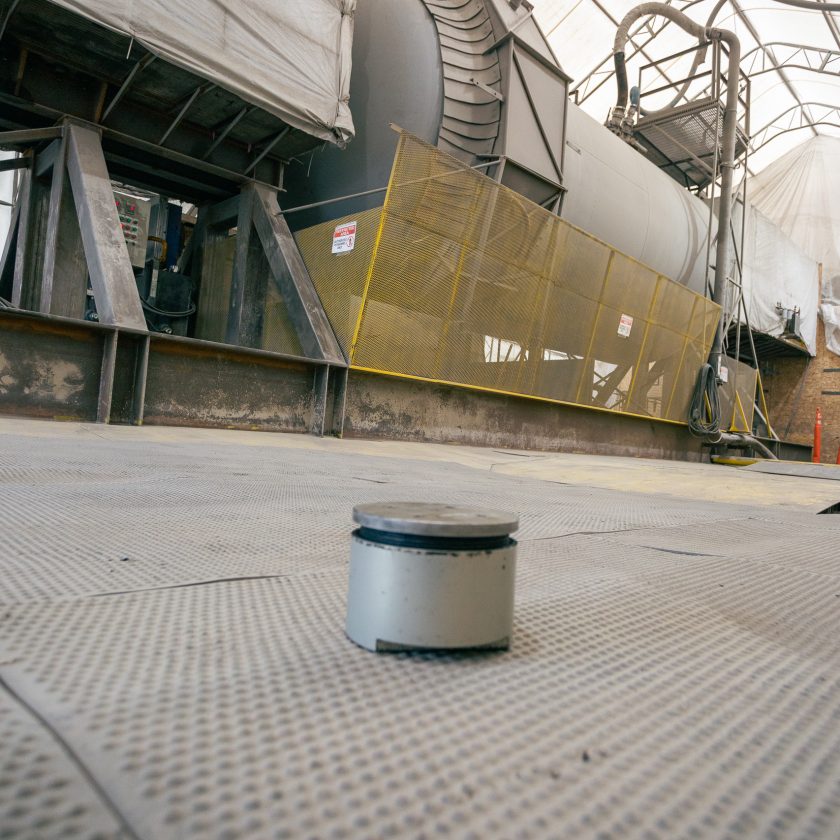Bridgestone Opens First U.S. Mining Tire Manufacturing Facility.
By Steve Fiscor
Extending its leadership in the heavy-duty, earthmoving tire segment, Bridgestone Americas opened its first giant off-road radial tire plant during November. Based in Aiken County, S.C., the 1.5 million-sq.-ft.  manufacturing facility produces various off-road radial tires for mining equipment, including ultra-class haul trucks. The new plant strengthens Bridgestone’s ability to meet global demand for mining tires now and in the future.
manufacturing facility produces various off-road radial tires for mining equipment, including ultra-class haul trucks. The new plant strengthens Bridgestone’s ability to meet global demand for mining tires now and in the future.
About 400 people, including several mining executives, gathered to commemorate the grand opening. The Aiken County Plant Manager Ron Brooks emceed the ceremony, which included speeches from Kazuhisa Nishigai, COO, Bridgestone Corp., and Gary Garfield, president and CEO of Bridgestone Americas, along with other Bridgestone executives and regional dignitaries.
“Bridgestone has made significant investments in technology and training to ensure we are producing the world’s leading off road radial tires for the mining business in North America,” said Nishigai. “We remain highly committed to our mining customers around the globe and will continue to make the right investments for this important segment of our business.”
This is a first; previously all of Bridgestone’s large mining class tires were manufactured in Japan. In 2011, the company announced a planned $970 million investment to build the company’s first U.S.-based off road radial tire plant, as well as expand production capacity at Bridgestone’s steel cord manufacturing facilities in Clarksville, Tennessee, and Saga, Japan. The opening of the Aiken County Off Road Radial Tire Plant completes the largest portion of this planned investment.
“Engineering large and ultra-large mining tires is a highly technical process, and Bridgestone has a long tradition of being a leader in bringing these tires to market. The opening of a new off road radial tire plant in South Carolina is a strategic business decision that will give us the capacity to build these tires domestically and improve our supply systems globally,” Garfield said. “Long term, the mining segment will grow, and we are now better-positioned to respond more quickly, efficiently and reliably to the needs of our customers.”
“The new Aiken plant will contribute significantly to our global business and to maintain our status as the leading tire supplier for the mining business,” Nishigai said. “Producing tires is a highly technical business and none is more difficult to produce than mining-class off road radial tires. We have made a significant investment in technology to ensure that we are producing the world’s leading off road mining tires here at the Aiken County facility. We expect the Aiken plant to make a very important contribution to customer satisfaction.”
Nishigai also explained that being the leader in this industry, also means being a leader as far as safety, sustainability, and protecting and preserving the environment. “This new facility features our biggest commitment to the tire manufacturing process in a sustainable, environmentally conscience manner,” Nishigai said. “As example, the plant uses solar panels to improve lighting and reduce costs. Water conservation was a primary consideration in the plant’s overall design. We plan to recycle nearly all of the plant’s waste.”
A Major Investment for the Americas
 This is the biggest single investment that Bridgestone has ever made in manufacturing in the U.S., Garfield explained. “Within the walls of the 1.5-million sq.-ft. facility, we will produce many of the world’s largest tires – massive off road radial tires to keep the mining industry on the move,” Garfield said. “This plant will help keep Bridgestone front and center in this important market segment throughout the Americas. This was a strategic business decision for our company. It keeps us well-positioned to take advantage of the market now and in the future. By installing Bridgestone’s state-of-the-art off road radial production technologies here in Aiken, we will be able to respond more quickly and dependably to customer needs throughout the Americas. It will strengthen our relationship with our customer base and strategically improve our supply systems globally.”
This is the biggest single investment that Bridgestone has ever made in manufacturing in the U.S., Garfield explained. “Within the walls of the 1.5-million sq.-ft. facility, we will produce many of the world’s largest tires – massive off road radial tires to keep the mining industry on the move,” Garfield said. “This plant will help keep Bridgestone front and center in this important market segment throughout the Americas. This was a strategic business decision for our company. It keeps us well-positioned to take advantage of the market now and in the future. By installing Bridgestone’s state-of-the-art off road radial production technologies here in Aiken, we will be able to respond more quickly and dependably to customer needs throughout the Americas. It will strengthen our relationship with our customer base and strategically improve our supply systems globally.”
It will also strengthen Bridgestone’s relationship with South Carolina. When the company made the announcement in 2011, the plans for the new plant and the expansion of the existing passenger tire plant amounted to the single largest capital investment in South Carolina’s history. “I’m very proud to say that we are creating every one of the 856 jobs that we said we would three years ago,” Garfield said.
Currently, nearly 2,000 people are employed at the two Aiken plants. During the next two years, the company will continue to hire people for both of these plants.
The Giant Tire Manufacturing Process
Manufacturing mining class tires, which can reach a height of 13 ft. high and weigh as much as 13,000 lb., is a complex process. During the first step of the tire manufacturing process, the raw materials are mixed. The various types of rubber and other raw materials that will go into the tire are carefully measured and mixed together in a powerful, three-floor Banbury mixer. More than 30 different components are used to make an off-road radial tire.
Next, each part of the tire required for assembly is created. The compound from the mixing process is extruded through a die to produce the desired profile for different components. Some of the mixed rubber is flattened, cooled and cut into different lengths for varying tire sizes. This becomes the sidewall and other parts of the tire.
The calendering process aligns hundreds of steel cords and binds them to the rubber, creating sheets of reinforced rubber for various components of the tire, including the belts and body ply. Steel wire is coated with rubber and then wrapped into a circular shape to create the bead, which is the part of the tire that connects to the wheel.
Those components are assembled to create a green tire (uncured). The tire is cured through a vulcanizing process using pressure and heat over time to cook the tire into the final shape. A bladder inflates the green tire and presses it against the mold at a precise temperature for a specific length of time to create the finished product.
The Aiken plant currently has four kilns that can accommodate several molds each.
The last step in the manufacturing process is the final inspection. The tires also pass through x-ray and ultrasound tests, as well as physical inspection by technicians, who use their hands, eyes and expertise to make sure every tire is top notch. Only after each tire passes all of Bridgestone’s quality inspections will it be released and sent to the customer.
A tire gets rejected less than 10 percent of the time. It depends on the abnormality, but the majority of the time tires are rejected for a surface blemish or something on the outside that is appearance related. Many times the technicians can buff and rework the outside of the tire. If an internal abnormality is detected through the X-ray or ultrasound process, the tire is scrapped and recycled. Bridgestone flew key technicians to Japan to be formally trained on the manufacturing process for ultra-class mining tires and they brought those skills back to the Aiken Plant.
A Commitment for the Business
Bridgestone has two mining-class tire plants in Japan. Importing these giant tires into the U.S. through West Coast ports can sometimes be problematic. That will no longer be the case for Bridgestone. And, with its close proximity to the Port of Charleston, the company can easily export tires to mines in Latin America.
“One of our great assets as an organization is the ability to leverage resources around the world,” said Kurt Danielson, president of U.S. & Canada Commercial Tire Sales, Bridgestone Americas Tire Operations. “In the past, we would transport the tires by ship and rail. Having tires produced and shipped domestically allows us to get the product to the mines in the Americas much more quickly.”
While he declined to give exact figures relating to the new plants production capacity for competitive reasons, Danielson explained that the capacity is certainly enough to satisfy the current demand throughout the Americas. “If there were another major upswing in the mining business, we would be better prepared to meet that demand.”
Steve Fiscor is editor of Coal Age and Engineering and Mining Journal magazines.




